Overrunning the habitats and keeping your tank tidy, aquarium snails come in various shapes and sizes. As a new snail keeper, it’s understandable if you have questions regarding how long your snails will live and how you can offer them a longer lifespan in captivity.
In this article, we’ll answer your queries and go through a few snail-keeping basics to keep you informed.
But before proceeding with anything, given how they’re such escape artists, make sure your snails haven’t pulled a Houdini and slipped out of their tank. We don’t need any snail jailbreaks on our hands!
Table of Contents
How Long Do Snails Live?
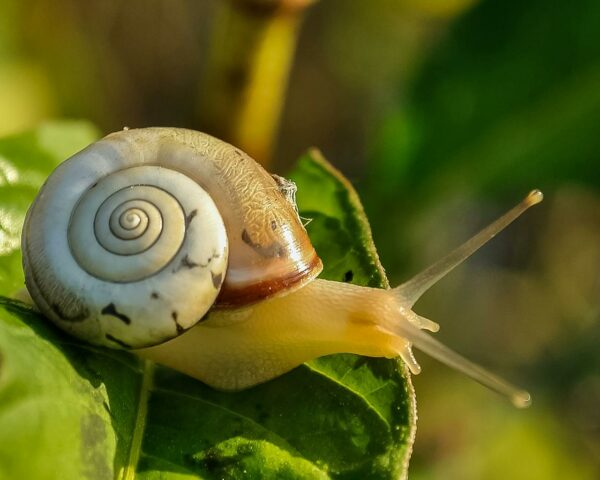
Depending on the species and genetics, your snails (any variety) are expected to live at least 2-3 years in the absence of predators and with proper care. However, some snails have a higher life expectancy and can live way beyond the average of 2-3 years and up to 5 years. Here are the typical lifespans of some common aquarium snail species:
1. Nerite Snails (Neritina spp.)
Average lifespan: 2-3 years
Nerite snails are a popular choice for freshwater aquariums. They are known for their beautiful patterned shells and their ability to eat a wide variety of algae. Unlike some “productive” snail species, nerite snails cannot reproduce in freshwater aquariums, so you need not worry about them overpopulating your tank.
2. Mystery Snails (Pomacea spp.)
Average lifespan: 2-4 years
Mystery snails are popular freshwater snails known for their large size and bright colors. They are excellent algae eaters and can also help to stir up the substrate, which helps with gas entrapment problems and manual cleaning.
3. Ramshorn Snails (Planorbidae family)
Average lifespan: 1-2 years
As we mentioned, Ramshorn snails are the type of aquarium snails that fanatically reproduce and overrun your tank. However, they can also be beneficial in a planted tank, as they help to stir up the substrate and keep it aerated. Keep their population in check if you have them.
4. Malaysian Trumpet Snails (Melanoides spp.)
Average lifespan: 2-5 years
Malaysian Trumpet Snails are another species of pet snails that often overrun the tanks and can never be eradicated unless you restart the habitat. They’re similarly capable to Ramshorn Snails in keeping substrates aerated.
5. Assassin Snails (Clea helena)
Average lifespan: 1-2 years
Introducing Assassin Snails in your tank can keep the population of pest snails in check. However, Assassin Snails aren’t as common in aquarium trade as the other mentions.
Snail Lifecycle Stages and Aging
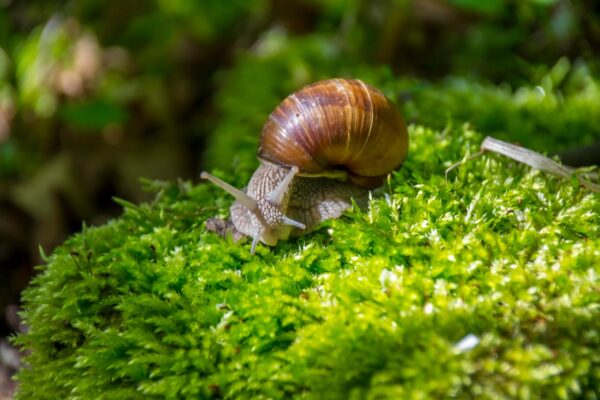
Begineer snail keepers often underestimate the importance of understanding the snail lifecycle and aging process to both care for them and prevent overpopulation. The prominent lifecycle stages of most aquarium snails are discussed here:
Egg Development and Hatching
Most aquarium snails are hermaphrodites. This means that they have both male and female reproductive organs and can asexually give birth to offspring, so a single snail can quickly raise the population in the tank.
Snails lay eggs in moist areas in clutches, inside gelatinous blobs or capsules. Depending on the species, the number of individual eggs in each capsule varies, but it’s not uncommon for each clutch to hold dozens of eggs.
It typically takes 2 to 6 weeks for the eggs to hatch. During this, the eggs often change to a more opaque color with embryo development.
When it’s time to hatch, snail hatchlings use their hatching tooth to break out of their egg shells and in some cases, eat the egg shells for calcium boost.
Juvenile Growth and Maturation
Juvenile aquarium snails go through a growth spurt after hatching. This lasts for around 1-2 weeks, during which, they focus their energy on rapidly growing their bodies and shells. Temperature, genetics, and nutrition are considered the key determining factors to their growth rate. Some experts even consider their exceptional growth rate as a natural adaptation in response to living in calcium-poor environments.
Juvenile snails live off algae and decaying plant matter, but a calcium-rich diet is essential to promote healthy growth and shell development. Aquarium snails reach sexual maturity over a few months to a year.
Also Read: Zebra Snail : Complete Guide To Care, Breeding, Tank Size And Disease
Adult Aging Processes and Senescence
Similar to other creatures, snails also are susceptible to cellular senescence, meaning their cells lose the ability to divide and function properly, limiting physiological processes and declining activity. As they age, you’ll find your snails becoming less active and showing signs of wear and tear on the shells. They would also stop egg production after a certain age.
Factors Affecting Snail Lifespan
Although snails are pretty resilient when it comes to water parameters, they still are affected by factors that reduce their lifespan dramatically. Some of them include:
Genetic Factors: Inherited Traits and Longevity
Variations in genes responsible for cellular repairs, stress resistance, and metabolism can influence a snail’s lifespan. As snails can reproduce asexually, the offspring produced in this way are unable to adapt to the changing environment and diseases can irradicate whole populations.
Some snail species are adapted to environments with high predation. These species often favor rapid growth and earlier sexual maturity, even over a longer lifespan.
Environmental Factors: Climate, Habitat, and Food Availability
Depending on your freshwater aquarium snail, you must ensure to deliver the proper water temperature, pH, water hardness, and nutrition. We have discussed them later in detail, but here is a quick overview of the parameters for the common aquarium snails:
Nerite Snails (Neritina spp.):
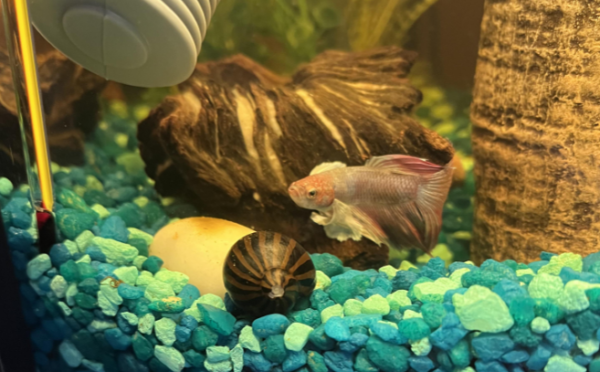
| Information Chart | Nerite Snails (Neritina spp.) |
| Care Level | Easy |
| Size | 0.5 to 1 inch |
| Diet | Omnivorous. Primarily algae eaters. Also east leftover fish food and decaying plant matter. Supplement their diet with blanched zucchini and cucumber. Calcium supplements like cuttlebone or crushed coral may help. |
| Temperature | 72 to 78F |
| pH Level | 7.0 to 8.0 |
| Water Hardness | 6 to 12 dKH |
| Tank Mate Compatibility | Avoid keeping them with pufferfish and loaches. |
Also Read: How To Check If A Snail Dead Or Sleeping: Complete Guide
Mystery Snails (Pomacea spp.):
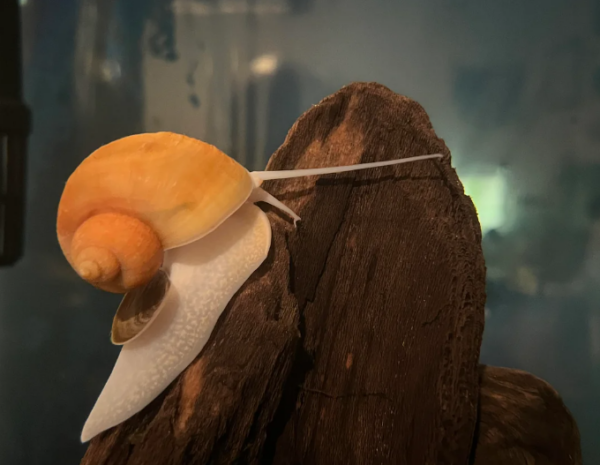
| Information Chart | Mystery Snails (Pomacea spp.) |
| Care Level | Easy |
| Size | Around 1 inch. Some varieties reach a slightly larger size. |
| Diet | Herbivorous. Primarily algae eaters. Feeds on some types of aquarium plants and would love to receive algae wafers and blanched zucchini or cucumbers. |
| Temperature | 72 to 78F |
| pH Level | 7.0 to 8.0 |
| Water Hardness | 6 to 12 dKH |
| Tank Mate Compatibility | Avoid keeping them with pufferfish and loaches. |
Ramshorn Snails (Planorbidae family):
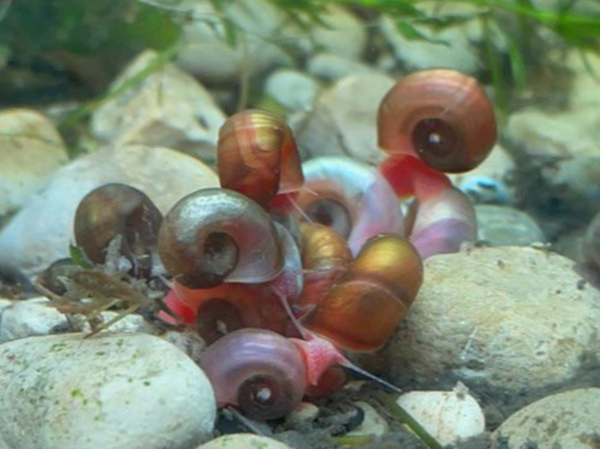
| Information Chart | Ramshorn Snails (Planorbidae family) |
| Care Level | Easy |
| Size | 1 inch in diameter |
| Diet | Omnivorous and feed on algae, detritus, and leftover food matter. Supplement their diet with blanched zucchini and cucumber. |
| Temperature | 70 to 78F |
| pH Level | 7.3 to 8.1 |
| Water Hardness | 5 to 10 dKH |
| Tank Mate Compatibility | Can reproduce rapidly. Introduce pufferfish and loaches to keep their population in check. |
Also Read: Snail Eggs: Complete Care Guide
Malaysian Trumpet Snails (Melanoides spp.):
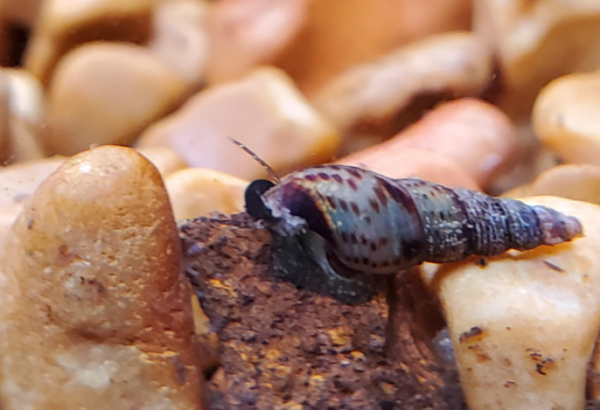
| Information Chart | Malaysian Trumpet Snails (Melanoides spp.) |
| Care Level | Easy |
| Size | 0.5 to 1 inch |
| Diet | Detrivores. Primarily feed on algae and organic matter in the substrate. Usually don’t require supplements as they burrow through the substrate and harvest the necessary nutrition. |
| Temperature | 73 to 77F |
| pH Level | 7.1 to 7.9 |
| Water Hardness | 6 to 10 dKH |
| Tank Mate Compatibility | Avoid keeping them with pufferfish and loaches. Keep them in aquariums with soft substrates to encourage their burrowing behavior. |
Assassin Snails (Clea helena):
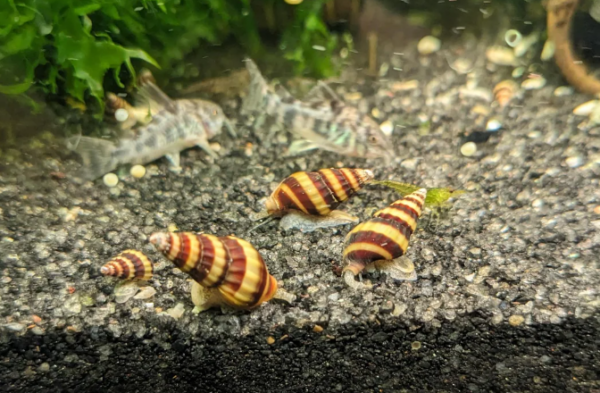
| Information Chart | Assassin Snails (Clea helena) |
| Care Level | Easy to moderate |
| Size | About 1 inch |
| Diet | Carnivorous. Feeds on other snails. May also feed on small crustaceans. If pest snails are unavailable, supplement their diet with sinking pellets and bloodworms. |
| Temperature | 75 to 82F |
| pH Level | 6.5 to 7.5 |
| Water Hardness | 6 to 12 dKH |
| Tank Mate Compatibility | Most community fish species are suitable. Avoid keeping them with smaller snails and crustaceans. |
Also Read: Bladder Snail: Complete Guide To Care, Breeding, Tank Size And Disease
Predation and Threats to Survival
Snails face various threats to their survival in both natural habitats and artificial waters. Some of them include:
- Predation by Fish
In the wild and sometimes in tanks, many fish species prey on snails, praying particularly on the smaller variants. Specialized adaptations, such as tooth plates in Pufferfish, allow crunching on the hard shells of the aquarium snails. Larger carnivorous fish may also prey on smaller snails.
- Predation by Other Snails
As mentioned, predatory snails, such as Assassin Snails, actively prey on smaller snails. This can lead to a decline in population among susceptible snail species.
- Habitat Loss
In the wild, habitat destruction and degradation can threaten the snail population in a certain area. These factors may include pollution, sedimentation, and habitat fragmentation.
- Competition
Larger snail populations may face a shortage of space and nutrition in both natural habitats and aquariums. As most snails primarily feed on algae and reproduce quickly, they can overrun the space and nutritional supply in aquariums.
- Diseases
Aquarium snails are susceptible to multiple diseases, including bacterial and fungal infections, parasitic infections, shell erosion, etc. A lack of genetic variations and a feeble lineage can eradicate whole snail populations during these outbreaks.
- Parameter Changes
Water parameters, such as pH, temperature, water hardness, chlorine levels, and many other factors, influence the overall lifespan of aquarium snails.
Care and Maintenance for Pet Snails
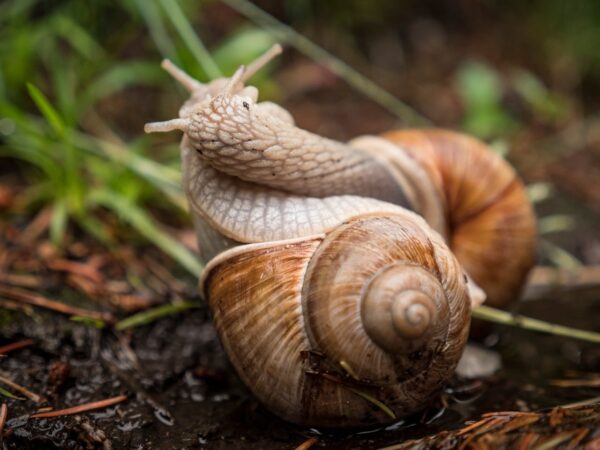
Let’s discuss how you can care for your pet snails and maintain optimal conditions.
1. Maintaining Parameters
The most fundamental water parameters that you need to maintain for snails are:
pH Maintenance
Suitable water pH levels ensure proper gas exchange, waste removal, and disease prevention. The first step is to test the water regularly for pH anomalies. Know the pH range your snails thrive in and strive to maintain them through regular water changes and using pH buffers.
However, avoid making drastic changes to the water and consider pH-reducing (driftwood, peat moss) or pH-raising (crushed coral, limestone) substrates for your tank.
Water Hardness Maintenace
Water hardness refers to the dissolved minerals in the water. While it’s essential for the health and well-being of your snails, excessive hardness can cause physiological issues.
Ensure that your aquarium has proper hardness by regularly testing the waters (test for both GH and KH). If anomalies are found, adjust it by either using RO/DI water to reduce hardness or using a specialized mineral salt mix to raise it.
Chlorine and Nitrite Maintenance
The presence of chlorine and nitrite is toxic for snails and aquatic creatures. Test the water regularly. Proper filtration with the presence of beneficial bacteria and plants can eliminate both from the tank.
Nitrate, on the other hand, promotes algae growth and may supply snails with additional nutrition. But, it’s advisable to also test it regularly and eliminate it through water changes.
Water Temperature Maintenance
Maintaining a stable and appropriate water temperature is critical for the health of your aquarium snails. Here are some strategies to achieve this:
- Use an appropriately sufficient heater during the colder months. Place the heater near the filter output.
- Decrease surface agitation to reduce evaporation and keep the water warmer.
- Increase surface agitation with a wave maker to cool the water temperature.
- Water changes can reduce water temperature during summer.
- Keep the tank indoors and covered during warmer days to avoid overheating.
2. Health Monitoring and Disease Prevention
Here are the signs of a sick snail that may indicate underlying diseases:
- Lathergy. Snails are slow creatures. But, if your snail remains inactive for extended periods, it could be a sign of illness.
- Loss of appetite. Your snail refusing to eat both algae and dietary supplements for several days can indicate health issues.
- Shell deterioration. Cracks, holes, and excessive etching on the shell can be the signs of nutritional deficiencies and illness.
- Irregular behaviors. If your snail is struggling to hang onto surfaces or having a tough time orienting itself, it may have some internal parasitic issues.
3. Handling and Interaction Guidelines
Snails are fascinating creatures that can be caught and handled. That makes them susceptible to mishandling and abuse. Here are a few tips on interacting with your snails to prevent injuries and avoid stress:
- Snails are delicate creatures, so avoid grabbing them forcefully or picking them up by their shell.
- Use a soft net or gently scoop them up with a shallow container filled with tank water if you must move them.
- When interacting, try to be calm and avoid making abrupt gestures that introduce stress.
- Keep handling to a minimum and respect their habitat by not removing them from their preferred areas.
- Gently nudge your snails out of the way during water changes and tank maintenance.
- Avoid using harsh chemicals to clean gravel and glass.
FAQs
Depending on the species, pet snails living in optimum conditions can live up to 5 years. However, most aquarium snail species live between 2-3 years. Several factors, including breeding habits, nutrition, water parameters, and genetics contribute to their overall lifespan.
Most aquarium snails are safe to touch from your standpoint. They are pretty harmless themselves but may carry parasites harmful to us. However, your snails can be fatally harmed if mishandled. Be careful when interacting with them and follow our guidelines.
While snails might recognize us as a larger species feeding them, they aren’t capable of identifying individual humans. This means your snail won’t be able to meet and greet anytime soon.
Snails can’t bite. They only have a tongue with teeth that can give a harsh lick at best.
The Bottom Line
We’ve discussed all the details about aquarium snails, including how long snails live. Hopefully, you’ll now be able to give proper care to your aquarium snails and see them scraping the glass and decorations clean.
